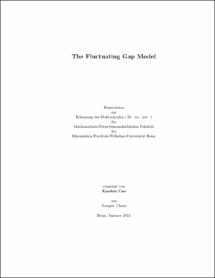The Fluctuating Gap Model

The Fluctuating Gap Model

| dc.contributor.advisor | Monien, Hartmut | |
| dc.contributor.author | Cao, Xiaobin | |
| dc.date.accessioned | 2020-04-16T18:43:33Z | |
| dc.date.available | 2020-04-16T18:43:33Z | |
| dc.date.issued | 10.02.2011 | |
| dc.identifier.uri | https://hdl.handle.net/20.500.11811/4919 | |
| dc.description.abstract | The quasi-one-dimensional systems exhibit some unusual phenomenon, such as the Peierls instability, the pseudogap phenomena and the absence of a Fermi-Dirac distribution function line shape in the photoemission spectroscopy. Ever since the discovery of materials with highly anisotropic properties, it has been recognized that fluctuations play an important role above the three-dimensional phase transition. This regime where the precursor fluctuations are presented can be described by the so called fluctuating gap model (FGM) which was derived from the Froehlich Hamiltonian to study the low energy physics of the one-dimensional electron-phonon system. Not only is the FGM of great interest in the context of quasi-one-dimensional materials, liquid metal and spin waves above T_c in ferromagnets, but also in the semiclassical approximation of superconductivity, it is possible to replace the original three-dimensional problem by a directional average over effectively one-dimensional problem which in the weak coupling limit is described by the FGM. In this work, we investigate the FGM in a wide temperature range with different statistics of the order parameter fluctuations. We derive a formally exact solution to this problem and calculate the density of states, the spectral function and the optical conductivity. In our calculation, we show that a Dyson singularity appears in the low energy density of states for Gaussian fluctuations in the commensurate case. In the incommensurate case, there is no such kind of singularity, and the zero frequency density of states varies differently as a function of the correlation lengths for different statistics of the order parameter fluctuations. Using the density of states we calculated with non-Gaussian order parameter fluctuations, we are able to calculate the static spin susceptibility which agrees with the experimental data very well. In the calculation of the spectral functions, we show that as the correlation increases, the quasi-particle peak broadens and splits into two bands, which indicates a break down of the Fermi liquid picture. The comparison between our results and those obtained using the second-order Born approximation shows that the perturbation theory is unreliable near the Fermi surface. Also with our non-Gaussian fluctuations, our calculation of spectral functions can explain the experimental angle-resolved photoemission spectroscopy (ARPES) data in a reasonable way. At last, the optical conductivity calculation confirms a zero dc conductivity in our model, and suggests that a finite dc conductivity obtained in a former calculation is just an artifact of the perturbation theory. | en |
| dc.language.iso | eng | |
| dc.rights | In Copyright | |
| dc.rights.uri | http://rightsstatements.org/vocab/InC/1.0/ | |
| dc.subject.ddc | 530 Physik | |
| dc.title | The Fluctuating Gap Model | |
| dc.type | Dissertation oder Habilitation | |
| dc.publisher.name | Universitäts- und Landesbibliothek Bonn | |
| dc.publisher.location | Bonn | |
| dc.rights.accessRights | openAccess | |
| dc.identifier.urn | https://nbn-resolving.org/urn:nbn:de:hbz:5N-24148 | |
| ulbbn.pubtype | Erstveröffentlichung | |
| ulbbnediss.affiliation.name | Rheinische Friedrich-Wilhelms-Universität Bonn | |
| ulbbnediss.affiliation.location | Bonn | |
| ulbbnediss.thesis.level | Dissertation | |
| ulbbnediss.dissID | 2414 | |
| ulbbnediss.date.accepted | 25.01.2011 | |
| ulbbnediss.fakultaet | Mathematisch-Naturwissenschaftliche Fakultät | |
| dc.contributor.coReferee | Urbach, Carsten |
Dateien zu dieser Ressource
Das Dokument erscheint in:
-
E-Dissertationen (4379)




